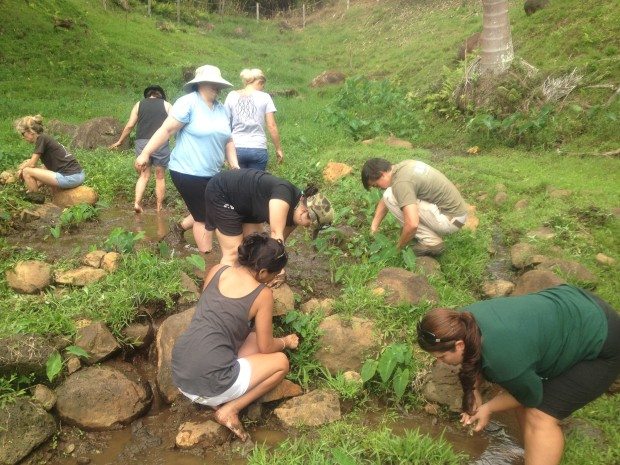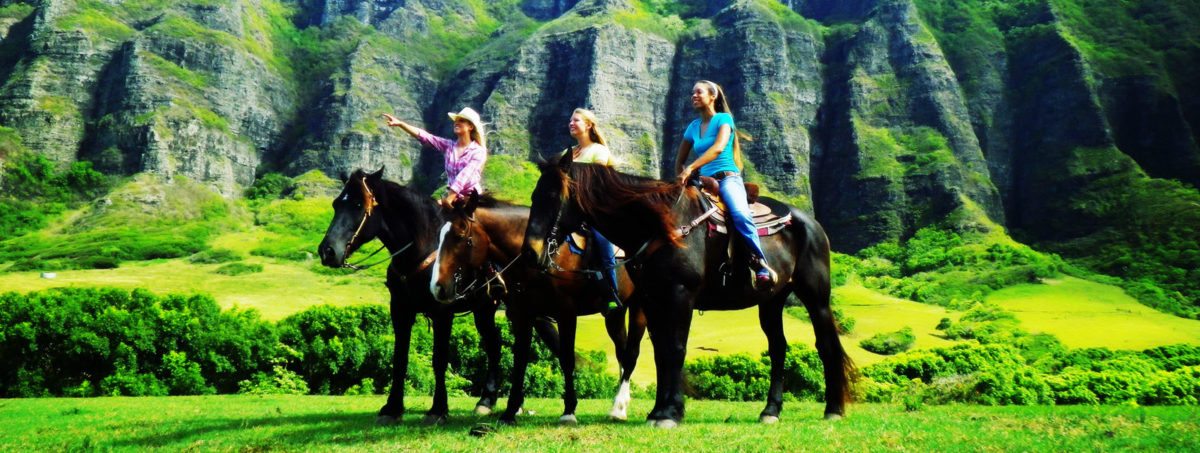Natural Focus …
Kualoa’s stewardship, recreation & education programs take place on some of the most beautiful places on the island of O’ahu. The guided and narrated tours showcase the natural beauty and give guests a close-up opportunity to enjoy the beauty and culture of Hawai‘i. Tour guides also give guests information about Kualoa’s paniolo (cowboy) history, Movie history as well as Kualoa’s agricultural, aquaculture, geology, flora and fauna.

Environmental Conservation …
Kualoa is not only dedicated to preserving its property from development, it also committed to doing what it can to promote the conservation and restoration of many of the native ecosystems on the property; fishponds, forests and coastal areas. A primary mission to malama’ āina (care for and preserve the native environment) is part of Kualoa’s employee training and shared with guests on all of the property tours.
Some of the ongoing initiatives include the upkeep and restoration of the 125-acre, 800 year old ancient Hawaiian Moli`i fishpond where employees and volunteer community work groups remove invasive plants and fish species. Other projects include protecting rare and endangered plants by fencing off areas with high concentrations of native plants, re-planting endangered plants, restoring taro patches (lo‘i), clearing streams, rebuilding natural rock walls and invasive weed control. Participating groups in these projects include community groups, company projects, student groups and employees. The goal is to expand participation to guests in the near future by providing unique “voluntourism” opportunities.
Kualoa supports these initiatives through its Education and Stewardship Departments. The professional staff in these departments continue to provide and maintain interpretive material dealing with the native environment and is charged with the education of customers, guests, and the community in regards to these materials. Last year, over 14,000 local keiki (children), mostly 4th and 7th graders, were able to visit Kualoa and learn through the education and stewardship programs.

Cultural & Historical Stewardship …
Kualoa has an incredibly rich Hawaiian cultural history. Hawaiian legends and recorded history illustrate the significance and uniqueness of Kualoa’s lands to the ancient Hawaiian people. It is part of the company mission to honor and perpetuate an understanding of this legacy. This is done in many ways. Hawaiian cultural sensitivities and protocols are respected and interpreted through the assistance of outside experts as well as dedicated staff members. Kualoa’s Human Resources Department retains a dedicated Cultural Trainer who presents monthly classes to all of Kualoa’s 300+ employees on Hawaiian culture and history. Tours are also monitored to ensure guests receive a proper and correct Hawaiian cultural experience. More than half of the employees of Kualoa are of native Hawaiian ancestry and several are educated in the language and culture. Kualoa also is proud of the many educational exhibits throughout the property that help communicate different and interesting aspects of the Hawaiian history and culture.
Contributions to the Local Community …
Being a good “corporate citizen” is a very important goal for Kualoa, and the company contributes in many ways. The most notable of these is through its education programs, headquartered at the Hakipuʽu Educational Center. About 14,000 local school children participate in its company subsidized programs each year.
Kualoa also supports the purchasing of local products and services and will use local resources over imported whenever possible. In addition, Kualoa remains dedicated to its core business of agriculture and has a long-term goal of serving many of the products it grows to guests as well as supporting local farmers in the area.
Whenever possible, Kualoa strives to provide support to neighborhood groups, schools, events and activities by contributing monetary donations, in-kind donations, providing employee volunteers and encouraging staff to participate in community committees, boards and projects.









